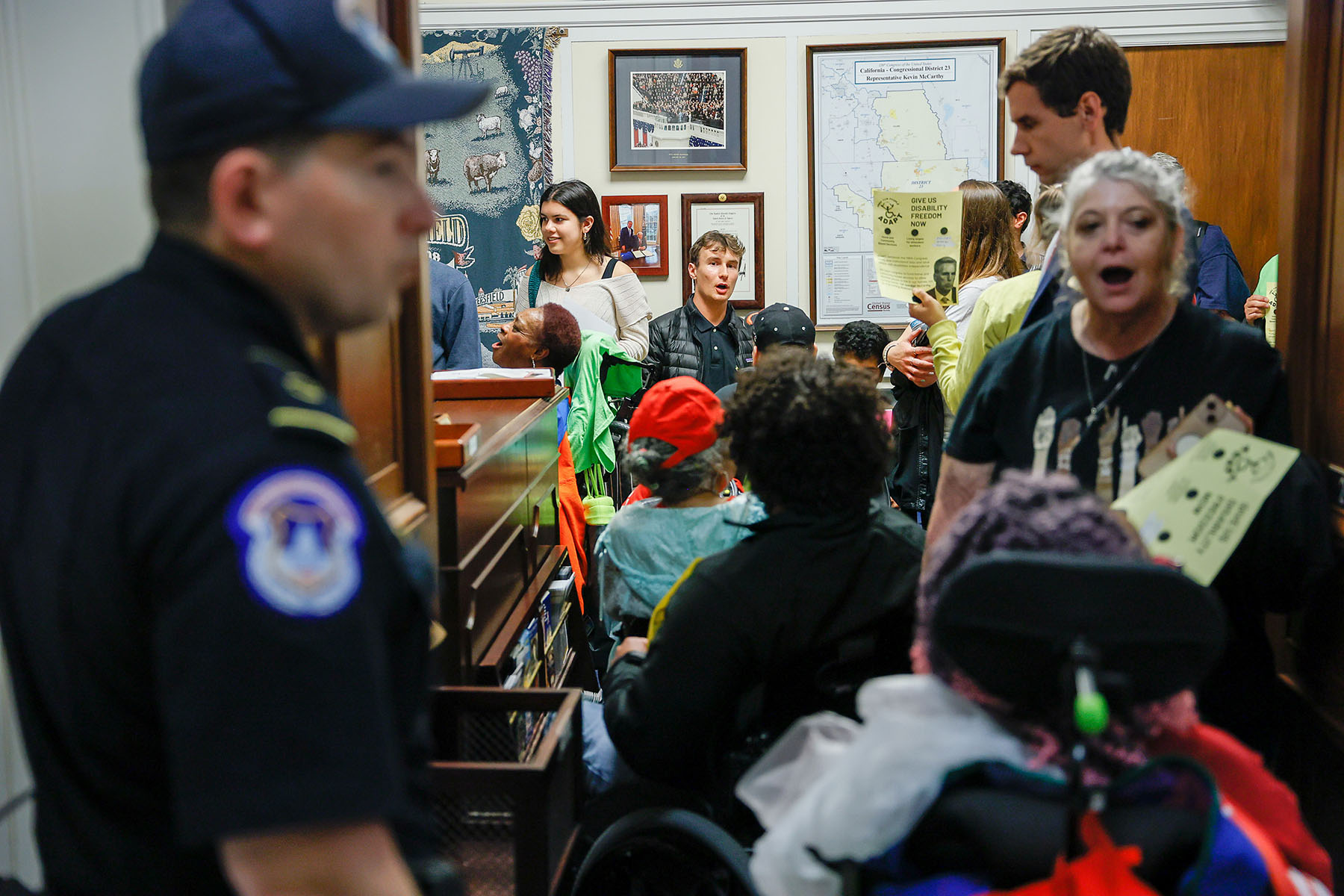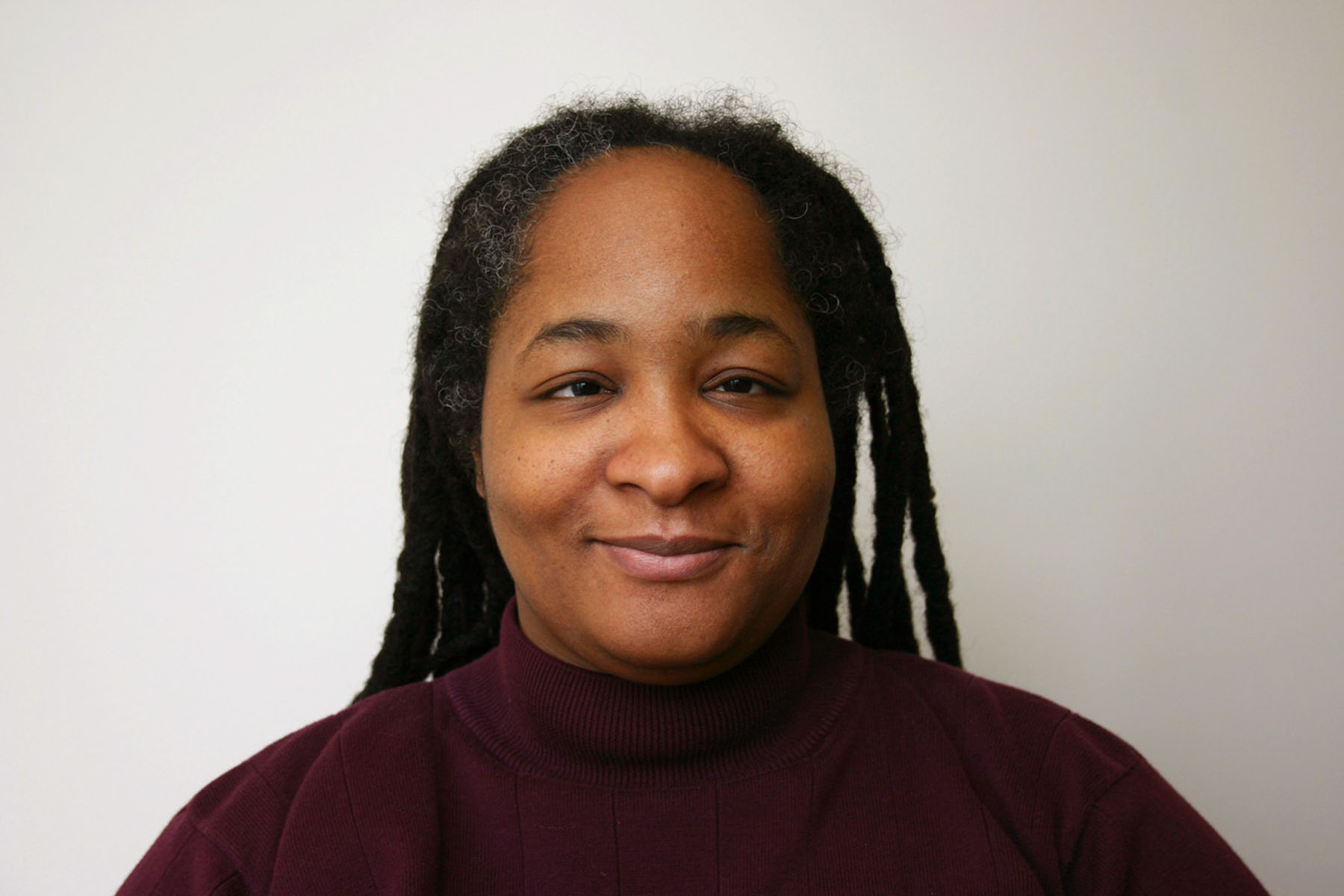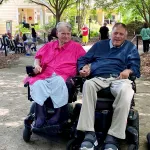We’re telling the untold stories of women, women of color and LGBTQ+ people. Sign up for our daily newsletter.
Longtime activist Anita Cameron is an institution in the disability community. She’s been an integral part of the disability rights protest group ADAPT and currently serves as director of minority outreach for Not Dead Yet, a national disability rights organization that opposes medical aid in dying.
She has been arrested over 100 times protesting for various disability rights issues — everything from advocating for wheelchair lifts on buses to pushing to expand home care.
ADAPT was perhaps at its most mainstream and visible during the summer of 2017, when protesters were photographed being dragged out of their wheelchairs by Capitol police while protesting proposed cuts to Medicaid, but they have been a steady presence in disability advocacy and organizing for decades.
After 37 years, Cameron, 57, is retiring from direct action. On May 9, The 19th joined her for her final march with ADAPT in Washington, D.C.
The 19th followed the group of 60 to 70 protesters from a Holiday Inn near L’Enfant Plaza down C Street towards the Capitol. It was the largest ADAPT protest since before the COVID-19 pandemic began.
Protesters, mostly in wheelchairs, some with white canes, blocked traffic and chanted “affordable, accessible integrated housing!” They wore homemade cardboard hats shaped like houses.
Cameron marched most of the way to the Capitol using a walker, but had to stop because she was too ill to continue. The 19th caught up with her after the protest was over, to talk about her thoughts on her final protest, ADAPT’s complicated history, the role of protest in advocacy and what she plans on doing for her second act.
This interview has been edited for length and clarity.
Sara Luterman: We got separated at the action. I met up with ADAPT at your hotel and followed about 60 protesters down C Street towards the Capitol to do a sit-in at Speaker Kevin McCarthy’s office. You had to stop marching and get into the wheelchair van ADAPT brought. What happened after that?
Anita Cameron: I got sick and was taken back to the hotel. So I didn’t get arrested [at my last action]. Someone called me and told me that there were arrests.
I ended up following ADAPT all the way to Speaker McCarthy’s office. Folks wheeled in and then refused to leave. There were arrests.
The next day, Wednesday, ADAPT went back to the Capitol, but I had to fly back to Rochester [N.Y.] to do speaking engagements around the “In This Moment” chapbooks. They highlight Black leaders of Rochester. I am the first disabled person who was featured.
And then I got on the plane at 5:30 on Thursday morning and went back to Washington, D.C. ADAPT went to the Department of Health and Human Services. I wound up going back to the hotel again because I was exhausted. I had gotten sick that morning. I had a seizure just as I was about to walk out the door and woke up four hours later and missed it.
This was a rough action for me because I was sick. That’s the reason that I’m retiring from active participation. I just can’t continue after 37 years of doing this. Activists die sometimes doing the work, and I don’t want to die doing the work. We’re at this point where I have to back off. It’s bittersweet.

What is ADAPT, for those who may not be familiar?
ADAPT is a national grassroots disability rights organization that was started in 1983. But the people who started ADAPT had been doing disability-related work, access to public transportation and public spaces, since at least 1978. That’s when the Gang of 19 did their action in Denver, fighting to add [wheelchair] lifts on buses. Denver became one of the first cities to install lifts on buses before the passage of the Americans with Disabilities Act required it.
I refer to it as our shot heard around the world. Other disabled folks heard about that action and contacted Wade [Blank, co-founder of ADAPT] and others in Colorado to say, “How do we do this too?” So they started doing trainings.
I joined ADAPT three years later in 1986, at the age of 21. I did local actions in Chicago, where I started out. And then I met Wade. He came to Chicago.
I went on my first national action in 1988, in Washington, D.C. We took over the Department of Transportation [protesting for wheelchair-accessible buses]. It was March. It felt like it was -4 degrees out. We held the building for 30 hours. I was the last person to get inside of the building. At the time, I could still walk. I was the only one able to walk around and help people with urine bags, feeding people and whatnot. I think [the Department of Transportation] turned off electricity and they wouldn’t give us access to bathrooms to try to get us to go away. It was just as cold inside the building as outside.
Mitch Snyder, who was an activist for houseless people in D.C., came down and gave us blankets. Justin Dart [widely recognized as the “father” of the Americans with Disabilities Act] came down.
I fell in love. I’d already found a home in ADAPT but I fell in love on that action.
What do you think the role of protest is in disability advocacy?
It’s what’s most effective. Some people can work on legislation, some people write letters. We do need a multipronged approach. But as far as I’m concerned, nonviolent civil disobedience, direct action, that’s what’s most effective. It takes years and years sometimes for legislation to get written and passed or for court cases to get done. Sometimes education works. But sometimes it doesn’t get you anywhere. When all of that doesn’t work, protest works.
Actions taken by ADAPT, particularly the Capitol Crawl [a protest in which disabled protesters crawled up the Capitol steps] – that’s what got us the Americans with Disabilities Act. Without us, the ADA would probably still be sitting in committees.
Not everyone likes the way we do things. Back in the day, we were called overly radical and militant. We were compared to the Black Panthers. As far as I’m concerned, that’s a badge of honor.
You’ve been to basically every major disability rights protest in the last 30 years, including the Capitol Crawl in 1990 and the 2017 Medicaid protests. A lot of people remember you being pulled out of your wheelchair by Capitol police. Which one do you think was the most important or impactful?
They were both extraordinarily important. We called 2017 the Summer of ADAPT. I was one of the ones dragged out of [Senate Majority Leader] Mitch McConnell’s office. I got dragged out of [Senator] Ron Portman’s office. It felt like a matter of life and death. If people lose access to [long-term care] services, that’s death. Even people with disabilities who work full-time jobs, you know, we rely on Medicaid for our attendant services for our durable medical equipment, all of that. It could have ended people’s lives.
Do you have any interesting stories you want to share?
I’ve been in some interesting jails. I’ve been arrested and held in some interesting places. In D.C., they don’t usually take us to jail. They usually process us beneath the Capitol, in the garage. In 1992 in San Francisco, they arrested us and the jail couldn’t handle the hundred folks in wheelchairs they arrested, so they took us to the dock of the Bay. It always makes me think of that Otis Redding song.
In Philadelphia, ADAPT actually had to sue because the only jail wasn’t accessible. We were protesting the lack of curb cuts in the city. When they arrested us, they took us to the jail in ambulances. They left the ambulances in front of the jail and they just couldn’t figure out what in the world they were going to do with us, so they wound up releasing us.
We were arrested at the Grand Ole Opry in Nashville, in 1993. We were protesting at the Grand Ole Opry because the American Health Care Association [a large nursing home industry lobbying group] was having their conference there. It was around the time of the Country Music Awards, which they have at the Grand Ole Opry. I think they were worried ADAPT was going to protest the awards, but a lot of us love country music. We don’t have any issue with country music.
We actually met with several of the country music stars, or at least they came and met us and talked to us. I’ll never forget, William Lee Golden from the Oak Ridge Boys came up to me, and I went to shake his hand and he hugged me. We gave them ADAPT gear and ADAPT buttons.
The action that really made me the way I am was in Sparks, Nevada, which is just outside of Reno. It was 1989. We got arrested and [held for] three days in Washoe County Jail. They put some of us in the infirmary. My friend Gwen Jackson from Chicago – Gwen couldn’t get herself any water by herself [because of her disability]. She needed help. She was begging for water, she was so thirsty. I banged on the door to get the correctional officers to go give her some water a couple of times, but they just ignored me. So I got angry and started banging on the door for an hour straight.
And so they came and I said, “You’re going to get her water! You’re going to get her water!” They ended up sending me back to general population. But that moment changed me. It turned me into the loudmouth that I am today. I couldn’t stand to see someone being mistreated or ignored. She’s disabled. She couldn’t get her own water. She was thirsty, begging for water. And they just wanted to ignore her. That made me who I am. I can’t see injustice and not at least try to do something about it.
What do you consider the proudest moment of your protest career?
Once, I was getting arrested near Congressman John Lewis’s office – I think in the early 2000s. He came out to figure out what the commotion was and saw us being arrested. He stopped the arresting process and the police let him come through the crowd, shaking our hands and talking to us. I introduced myself to him and he hugged me and told me, “You keep on making good trouble.”
I’m working on a book now called “Troublemaker: The Life and Times of an Intersectional Activist.” And it was partially named after that, because I’m seen as a troublemaker. I make good trouble. That was my proudest moment.
ADAPT has a complicated history when it comes to race. Rosa Parks, for example, declined to support ADAPT’s battle for accessible busing in 1986. What are your thoughts as a longtime ADAPTer, and as someone who’s been outspoken about anti-Blackness in disability organizing?
A lot of ADAPT folks were pissed off about Rosa Parks. I wasn’t. I didn’t hold Rosa Parks responsible for that and I don’t think we should have. You’re not going to have me, a Black woman, criticizing another Black woman who paid her dues.
She was older, she had her advisors. They probably didn’t think it was wise for her. I don’t put that on Rosa Parks.
Back then, at the local level, there weren’t too many of us Black folks [in ADAPT]. I used to get told I needed to leave my Blackness at the door. I didn’t know how. I couldn’t. I can’t. I can’t separate my Blackness and my woman-ness from my disability.
I tried for years to bring race up with ADAPT and got dismissed. Some people nicknamed me an “angry Black woman.” In 2018, I pushed them to form an intersectional justice workgroup, to look at other issues.
Some White people in ADAPT would say stuff like, “Immigration isn’t our issue.” But we have ADAPT members who are undocumented, who have green cards, who immigrated to this country. It is our issue.
It kind of blew up in my face a bit because folks weren’t ready to talk about race and intersectionality.
In 2019, there was a split in ADAPT [over an incident involving former leader Bruce Darling and comments he made regarding immigrants]. Entire chapters just quit, decided they’d rather be racist. I got called horrific names. I was told that I didn’t care about disabled people, that I only cared about Black people. It feels like a failure of mine. ADAPT just wasn’t ready for that conversation.
You’re retiring from direct action. What are you planning on doing for your second act?
I’m mostly writing. I wrote a children’s book for the Itty Bitty Bio series about my participation in the Capitol Crawl. It was interesting writing a very short book using age-appropriate language. I am working on getting my autobiography, “Troublemaker,” edited and published.
Right now I’m writing a paper on the erasure of Black disabled activists from disability history. I want to do a whole project. I want to get the stories of Black disabled activists who did the work, but nobody knows their names. I don’t know if it’s going to be a documentary or a podcast or what yet. I want to get these stories before everybody goes on to the ancestors and their stories don’t get told.
What is the future of ADAPT?
It’s hard to tell what the future of ADAPT will be. There were 70 people at my final action, which is the largest amount of people we’ve had since 2019, when the split happened. After the split, we’d be lucky if we had 20 or 30 people. But this last action we had 70, and a lot of them were newer and younger people. The young folks that I spoke to, at this action, they loved it, and they want to come back.
Hopefully, ADAPT continues to grow, but I think that ADAPT is going to have to address some stuff to become stronger. Just because you put a Black person or two in leadership positions, it does not mean you’ve dealt with the racism issue. I’ve been in situations where I was in leadership, but I was tokenized. You can put Black folks out there, but if you’re not addressing systemic structural racism, if you’re not looking at intersectional issues that you know, you have a gap.
There are ADAPTers who are Black and Latino, Asian, Native American, who are LGBTQ, who are trans, and we have to address their issues.







